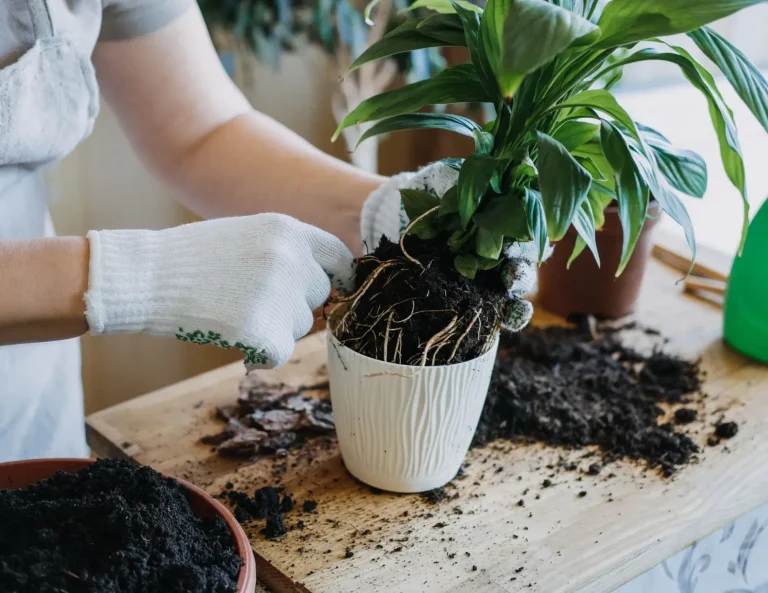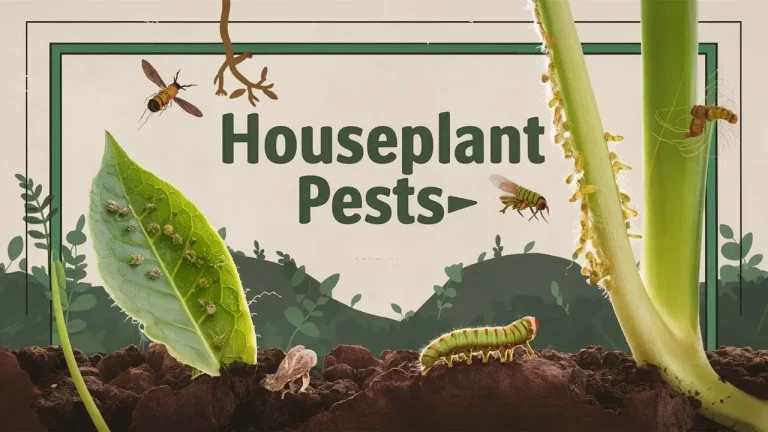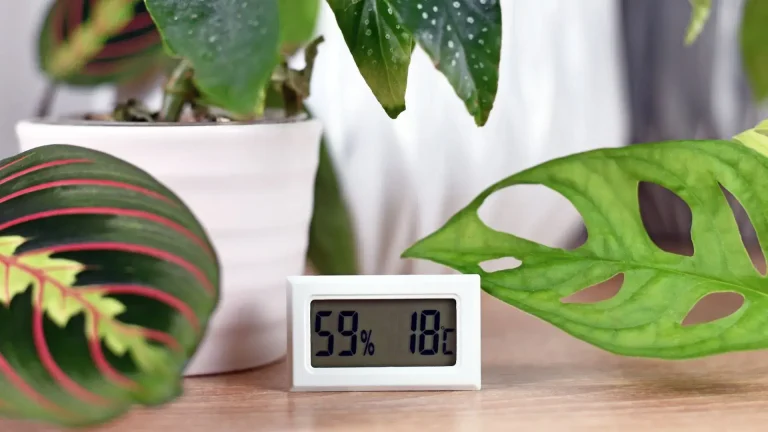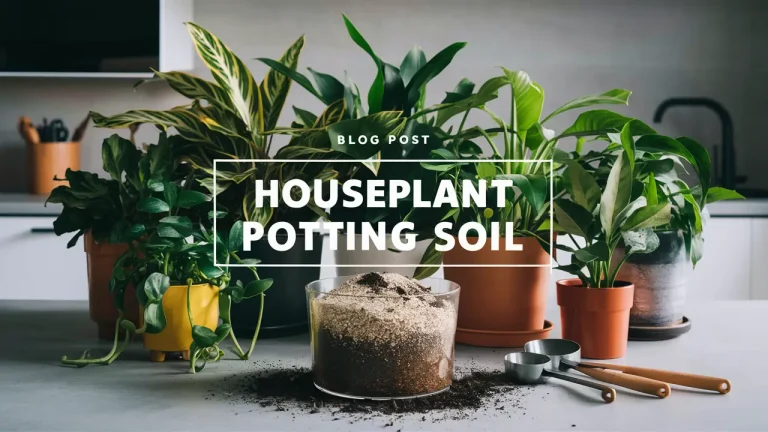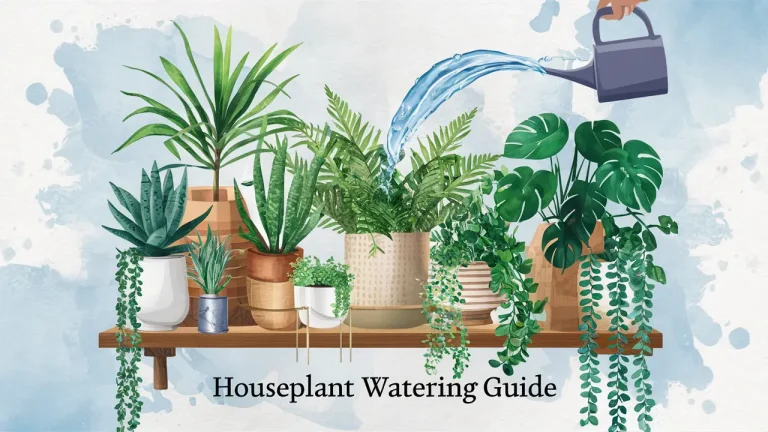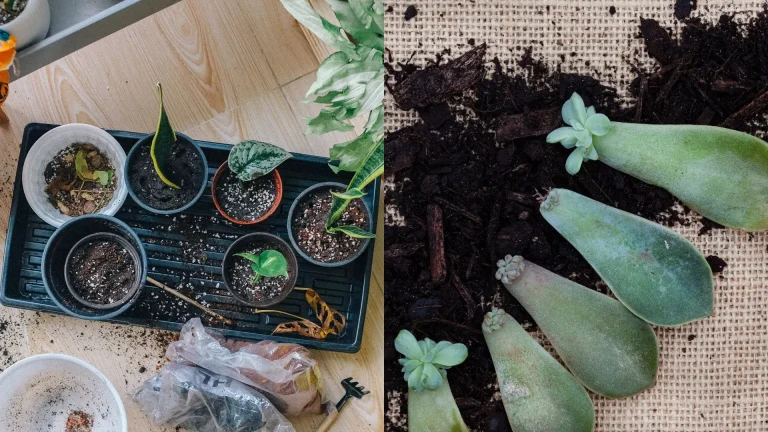Fertilizing Houseplants: A Complete Guide to Healthy, Vibrant Plants
Healthy, lush houseplants don’t just thrive on water and sunlight—they also need the right nutrients to grow, bloom, and stay vibrant. Fertilizing is a crucial part of indoor plant care, providing essential nourishment that helps your plants flourish.
In their natural environment, plants draw nutrients from the soil, rain, and organic matter. But houseplants depend on you to replenish their nutrient supply, especially since soil in pots depletes over time. Without proper feeding, plants may show slow growth, pale leaves, or fail to bloom.
In this guide, we’ll cover everything you need to know about houseplant fertilization, including the different types of fertilizers, when and how to use them, and common mistakes to avoid. Whether you’re a beginner or a seasoned plant parent, these tips will help you give your green companions the care they deserve.
Table of Contents
Why Plants Need Fertilizers
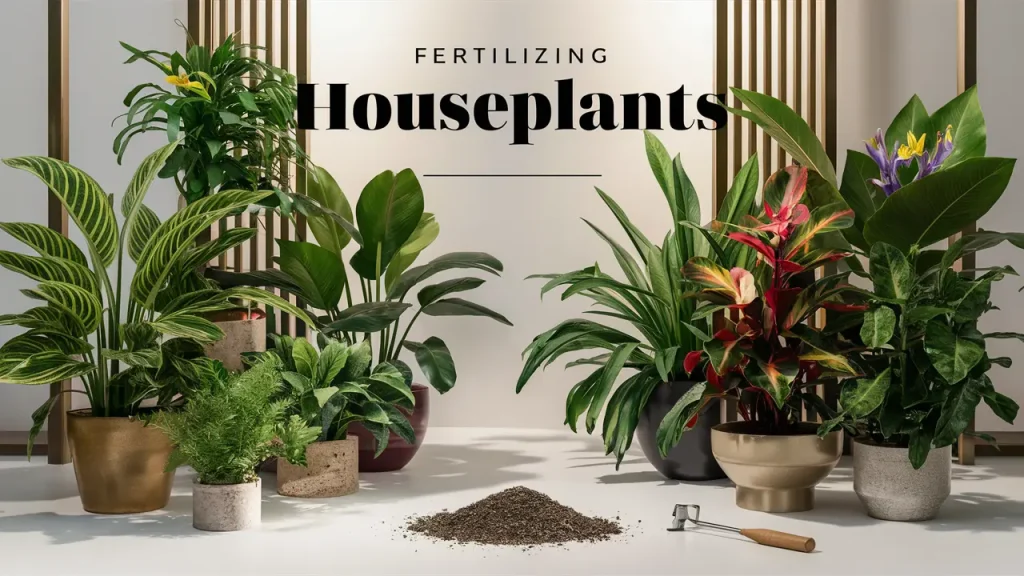
The soil in pots is a closed system, meaning nutrients are not naturally replenished as they are outdoors. Each time you water your plants, nutrients like nitrogen, phosphorus, and potassium are washed away. Over time, this depletion leads to nutrient-poor soil that cannot support healthy plant growth.
Fertilizers are a vital solution to nutrient depletion. They provide a balanced mix of macronutrients, secondary nutrients, and micronutrients that plants need to grow, produce vibrant foliage, and resist disease. By replenishing these essential elements, fertilizers ensure that your plants remain healthy and strong, even in the confined conditions of a pot.
Nutrient Breakdown: What Your Plants Need
1. Macronutrients
Macronutrients are the primary elements plants need in large amounts to grow and thrive:
- Nitrogen (N): Promotes lush, green foliage by encouraging leaf and stem growth. Essential for photosynthesis.
- Phosphorus (P): Supports strong root systems and aids in flower and fruit development.
- Potassium (K): Improves overall plant health, strengthens cell walls, and boosts resistance to diseases.
2. Secondary Nutrients
Though needed in smaller amounts than macronutrients, secondary nutrients are still crucial:
- Calcium (Ca): Enhances cell wall strength and helps prevent issues like blossom end rot.
- Magnesium (Mg): Central to photosynthesis, as it is a key component of chlorophyll.
- Sulfur (S): Helps with protein production and enhances plant enzyme activity.
3. Micronutrients
Micronutrients are required in trace amounts but play an essential role in plant health:
- Iron (Fe): Vital for chlorophyll production and green, healthy leaves.
- Manganese (Mn): Supports enzyme function and nutrient absorption.
- Zinc (Zn): Aids in hormone production and overall growth regulation.
Organic vs. Synthetic Fertilizers
Organic Fertilizers
Organic fertilizers are derived from natural materials such as plant and animal byproducts. Examples include compost, worm castings, fish emulsion, and bone meal.
- Pros:
- Improve soil structure and microbial activity over time.
- Eco-friendly and sustainable.
- Release nutrients slowly, reducing the risk of over-fertilization.
- Cons:
- Nutrient release is slower, which may not meet immediate plant needs.
- Can have an unpleasant odor in some cases.
Synthetic Fertilizers
Synthetic fertilizers are chemically manufactured to provide precise nutrient ratios. They often come in granular, liquid, or slow-release forms.
- Pros:
- Act quickly, delivering nutrients to plants almost immediately.
- Easy to measure and apply, with specific NPK ratios tailored to plant needs.
- Cons:
- Can lead to over-fertilization if not used carefully, potentially damaging plants.
- Do not improve soil health or microbial activity.
Fertilizer Numbers Meaning (NPK Ratio)
The three numbers on a fertilizer label, such as 10-10-10, represent the percentages of primary macronutrients:
- Nitrogen (N): The first number indicates the nitrogen content, which promotes lush, green foliage and healthy leaf development.
- Phosphorus (P): The second number shows the phosphorus content, crucial for strong root growth and flower or fruit production.
- Potassium (K): The third number represents potassium, which strengthens plant health, improves disease resistance, and supports overall vigor.
For example, a fertilizer labeled 5-10-10 contains 5% nitrogen, 10% phosphorus, and 10% potassium by weight. The remaining percentage consists of other elements or fillers that may be present in the fertilizer.
Types of Fertilizers for Indoor Plants
1. Liquid Fertilizers
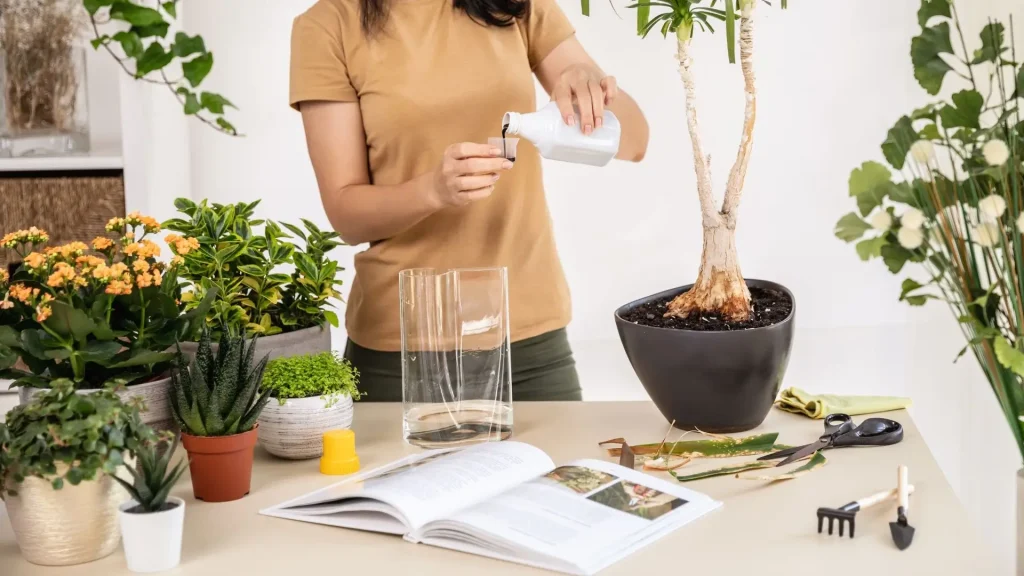
- Description: Concentrated liquids diluted in water for application.
- Benefits:
- Quick nutrient absorption.
- Easy to measure and customize for different plants.
- Ideal For: Fast-growing plants or those needing immediate nutrient boosts.
2. Slow-Release Fertilizers
- Description: Granules or pellets that break down gradually over weeks or months, releasing nutrients slowly.
- Benefits:
- Reduces the frequency of feeding.
- Provides consistent nutrition over time.
- Ideal For: Busy plant owners or plants with steady, moderate nutrient needs.
3. Water-Soluble Fertilizers
- Description: Powders mixed into water to create a liquid feed.
- Benefits:
- Combines the fast action of liquid fertilizers with easy storage.
- Allows for even distribution when watering.
- Ideal For: Plants that need regular feeding during their active growth stages.
4. Fertilizer Spikes
- Description: Solid spikes inserted into the soil near plant roots, slowly releasing nutrients over time.
- Benefits:
- Convenient and mess-free.
- Lasts for weeks with minimal maintenance.
- Limitations: Nutrient distribution can be uneven.
- Ideal For: Low-maintenance plants or hard-to-access pots.
How to Choose the Right Fertilizer
Selecting the best fertilizer for your houseplants depends on factors like plant type, growth stage, and personal preferences. Here’s how to make the right choice:
Consider Your Plant Type & NPK Ratio
- Tropical Plants (Monsteras, Philodendrons, Ferns): Use a balanced fertilizer with equal parts nitrogen, phosphorus, and potassium (e.g., 10-10-10 or 20-20-20) to support steady growth.
- Flowering Plants (African Violets, Anthuriums, Orchids): Choose a fertilizer higher in phosphorus to encourage blooms (e.g., 10-30-20).
- Succulents and Cacti: Opt for a low-nitrogen fertilizer (e.g., 2-7-7) to prevent overgrowth and support strong roots.
Match the Fertilizer to the Growth Stage
- Active Growth: Plants in their growing season (spring and summer) benefit from regular fertilization with a balanced formula.
- Dormant Phase: During fall and winter, most houseplants require little to no fertilizer as their growth slows.
Choose Based on Your Lifestyle
- For low-maintenance care, slow-release fertilizers are ideal since they require less frequent application.
- If you prefer to monitor your plants closely, liquid fertilizers provide more control and flexibility.
When and How Often to Fertilize
Knowing the right timing and frequency for fertilizing your houseplants can make all the difference.
Seasonal Guidelines
- Spring and Summer (Active Growth): Fertilize every 2-4 weeks with a diluted liquid fertilizer or apply slow-release granules at the beginning of the season.
- Fall and Winter (Dormancy): Reduce or stop fertilizing unless the plant is actively growing under artificial light.
Fertilizer Type & Frequency
- Liquid Fertilizer: Apply every 2-4 weeks, diluted to half the recommended strength to avoid overfeeding.
- Slow-Release Fertilizer: Reapply every 3-6 months, depending on the product instructions.
- Organic Fertilizer: Use compost tea or similar products monthly during the growing season.
Plant Type & Frequency
- Leafy Plants: Feed every 2–4 weeks during active growth.
- Flowering Plants: Feed weekly or bi-weekly during blooming seasons.
- Succulents and Cacti: Fertilize sparingly, about once a month or less, during spring and summer.
- Herbs: Fertilize monthly for steady growth and flavor production.
Signs Your Indoor Plants Need Fertilizer
- Yellowing Leaves: A lack of nitrogen or other nutrients can cause pale, yellowing foliage.
- Slow or Stunted Growth: If your plant stops producing new leaves or stems, it may need a nutrient boost.
- Fewer or No Flowers: Low phosphorus levels often result in poor flowering or complete bloom failure.
- Pale or Discolored Foliage: Micronutrient deficiencies, like iron or magnesium, can cause faded or spotty leaves.
How to Fertilize Your Houseplants
Fertilizing houseplants isn’t complicated, but following these steps ensures effective and safe feeding:
Step-by-Step Guide
- Water First: Before applying fertilizer, water the plant to prevent root burn.
- Dilute Liquid Fertilizer: Always dilute to the recommended strength or weaker. Over-concentrated fertilizer can damage plants.
- Apply Evenly: Pour the fertilizer solution evenly over the soil, avoiding direct contact with leaves.
- Observe and Adjust: Monitor your plant’s response. If growth improves and leaves look healthy, you’re on the right track.
Special Considerations
- Avoid fertilizing newly repotted plants for at least 4-6 weeks to allow roots to settle.
- For plants in low light or dormant states, reduce fertilizer to prevent overfeeding.
When Not to Fertilize Your Indoor Plants
There are times when fertilization can do more harm than good. Avoid fertilizing under the following conditions:
- During Dormancy or Periods of Stress: Plants rest during autumn and winter, requiring minimal nutrients. Similarly, stressed plants (e.g., recently repotted or pest-infested) should not be fertilized until they recover.
- When Plants Are Recovering from Over-Fertilization or Root Damage: If you’ve over-fertilized or your plant has root rot, avoid adding more nutrients. Focus on flushing the soil or providing appropriate care until recovery.
Troubleshooting Common Fertilization Issues
1. Over-Fertilization
Symptoms:
- Brown leaf tips
- A crusty white buildup on the soil surface
- Leaf drop
Solutions:
- Flush the soil with clean water to remove excess salts.
- Skip feeding for several weeks and monitor plant recovery.
2. Under-Fertilization
Symptoms:
- Pale or yellowing leaves
- Slow or stunted growth
- A lack of vibrancy
Solutions:
- Gradually increase the frequency or concentration of fertilizer applications.
- Ensure the fertilizer matches the plant’s nutrient requirements.
3. Uneven Growth
Symptoms:
- Lopsided growth
- Patches of healthy and unhealthy foliage
Solutions:
- Apply fertilizer evenly around the root zone.
- Rotate plants periodically to ensure equal light exposure and nutrient distribution.
Common Fertilizing Mistakes to Avoid
Even experienced plant parents can make fertilizing mistakes. Here’s how to avoid the most common pitfalls:
- Over-Fertilizing: Too much fertilizer can damage roots and cause salt buildup. Always start with less than recommended.
- Using the Wrong Formula: Match the fertilizer to your plant type and growth needs. For example, flowering plants need more phosphorus, while succulents need less nitrogen.
- Fertilizing at the Wrong Time: Avoid fertilizing plants during dormancy or right after repotting.
- Ignoring Soil Health: Fertilizer won’t fix poor drainage or compacted soil. Ensure the soil is healthy and well-draining before applying nutrients.
Fertilization Checklist
Use this quick-reference checklist to keep your fertilization practices on track:
Choose the Right Fertilizer for Your Plant: Match the NPK ratio and type (organic/synthetic) to your plant’s needs.
Follow the Proper Feeding Schedule: Fertilize according to the plant’s growth stage and seasonal requirements.
Adjust Feeding Based on Seasonal Changes: Increase feeding in spring and summer; reduce or pause in autumn and winter.
Monitor Your Plants for Signs of Nutrient Deficiency or Excess: Watch for yellowing leaves, stunted growth, or leaf tip burns as indicators of issues.
Use our Printable Planner to label each plant, making their needs clear at a glance!
Final Thoughts
Fertilization is a vital part of maintaining healthy, vibrant indoor plants. By understanding your plants’ specific nutrient needs, following a proper feeding schedule, and adjusting your practices based on their responses, you can create an optimal care routine.
- Observation is Key: Pay attention to how your plants react to fertilization and modify your approach accordingly.
- Balance Matters: Fertilization is just one aspect of care; it must work in harmony with proper watering, adequate light, and humidity management.
With consistent care and attention, your indoor plants can thrive and bring beauty to your home year-round.

